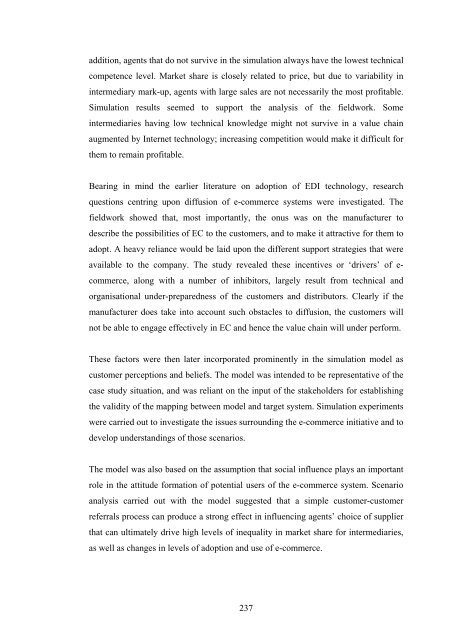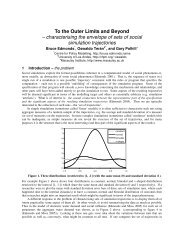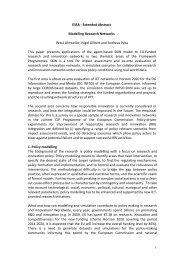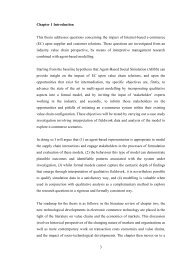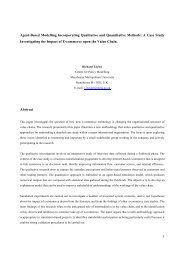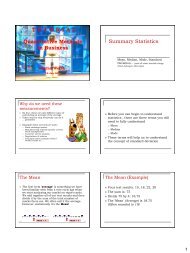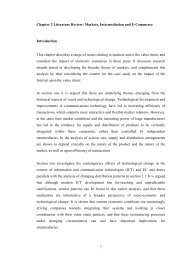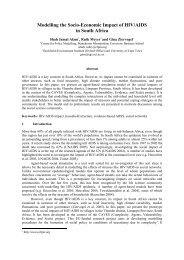222 Chapter 8 Discussion Introduction This chapter reflects on the ...
222 Chapter 8 Discussion Introduction This chapter reflects on the ...
222 Chapter 8 Discussion Introduction This chapter reflects on the ...
Create successful ePaper yourself
Turn your PDF publications into a flip-book with our unique Google optimized e-Paper software.
additi<strong>on</strong>, agents that do not survive in <strong>the</strong> simulati<strong>on</strong> always have <strong>the</strong> lowest technical<br />
competence level. Market share is closely related to price, but due to variability in<br />
intermediary mark-up, agents with large sales are not necessarily <strong>the</strong> most profitable.<br />
Simulati<strong>on</strong> results seemed to support <strong>the</strong> analysis of <strong>the</strong> fieldwork. Some<br />
intermediaries having low technical knowledge might not survive in a value chain<br />
augmented by Internet technology; increasing competiti<strong>on</strong> would make it difficult for<br />
<strong>the</strong>m to remain profitable.<br />
Bearing in mind <strong>the</strong> earlier literature <strong>on</strong> adopti<strong>on</strong> of EDI technology, research<br />
questi<strong>on</strong>s centring up<strong>on</strong> diffusi<strong>on</strong> of e-commerce systems were investigated. The<br />
fieldwork showed that, most importantly, <strong>the</strong> <strong>on</strong>us was <strong>on</strong> <strong>the</strong> manufacturer to<br />
describe <strong>the</strong> possibilities of EC to <strong>the</strong> customers, and to make it attractive for <strong>the</strong>m to<br />
adopt. A heavy reliance would be laid up<strong>on</strong> <strong>the</strong> different support strategies that were<br />
available to <strong>the</strong> company. The study revealed <strong>the</strong>se incentives or ‘drivers’ of e-<br />
commerce, al<strong>on</strong>g with a number of inhibitors, largely result from technical and<br />
organisati<strong>on</strong>al under-preparedness of <strong>the</strong> customers and distributors. Clearly if <strong>the</strong><br />
manufacturer does take into account such obstacles to diffusi<strong>on</strong>, <strong>the</strong> customers will<br />
not be able to engage effectively in EC and hence <strong>the</strong> value chain will under perform.<br />
These factors were <strong>the</strong>n later incorporated prominently in <strong>the</strong> simulati<strong>on</strong> model as<br />
customer percepti<strong>on</strong>s and beliefs. The model was intended to be representative of <strong>the</strong><br />
case study situati<strong>on</strong>, and was reliant <strong>on</strong> <strong>the</strong> input of <strong>the</strong> stakeholders for establishing<br />
<strong>the</strong> validity of <strong>the</strong> mapping between model and target system. Simulati<strong>on</strong> experiments<br />
were carried out to investigate <strong>the</strong> issues surrounding <strong>the</strong> e-commerce initiative and to<br />
develop understandings of those scenarios.<br />
The model was also based <strong>on</strong> <strong>the</strong> assumpti<strong>on</strong> that social influence plays an important<br />
role in <strong>the</strong> attitude formati<strong>on</strong> of potential users of <strong>the</strong> e-commerce system. Scenario<br />
analysis carried out with <strong>the</strong> model suggested that a simple customer-customer<br />
referrals process can produce a str<strong>on</strong>g effect in influencing agents’ choice of supplier<br />
that can ultimately drive high levels of inequality in market share for intermediaries,<br />
as well as changes in levels of adopti<strong>on</strong> and use of e-commerce.<br />
237


